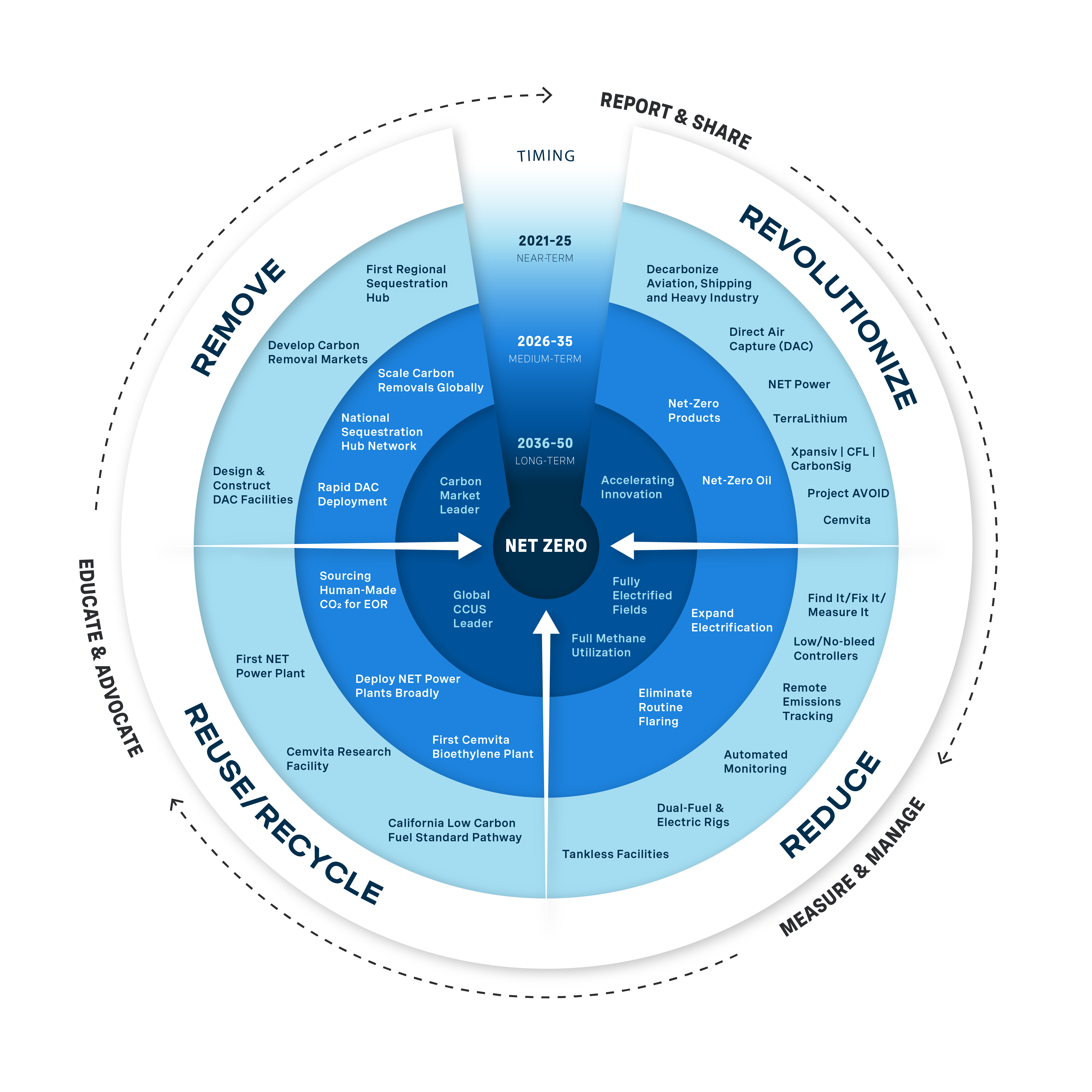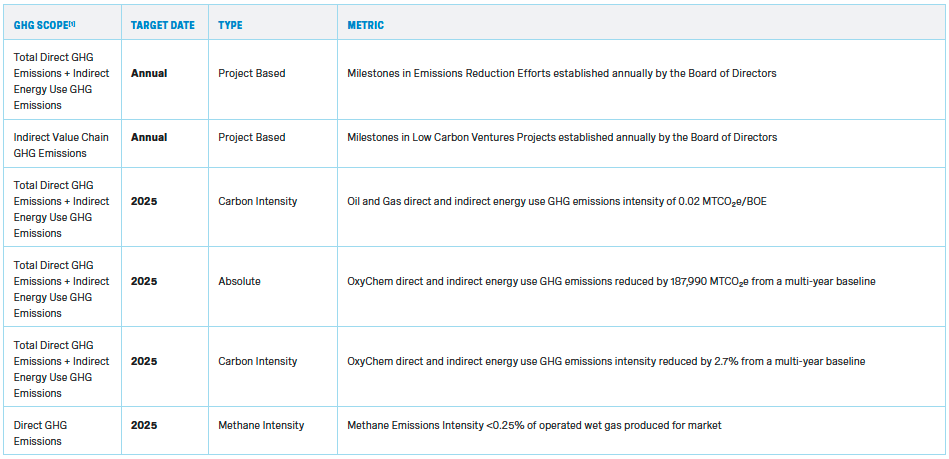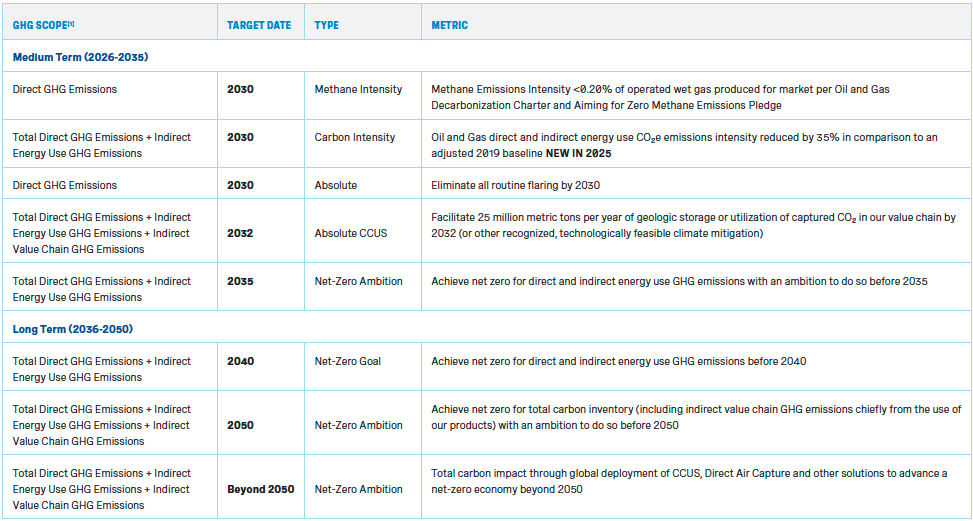Sustainability
Planet
Oxy's environmental stewardship is a responsibility of each member of our workforce. Our practices and performance focus on climate change, energy use and greenhouse gas emissions management, biodiversity and habitat conservation, and water and waste management.

ENVIRONMENTAL STEWARDSHIP AT OXY
At Oxy, we have a long-standing Health, Safety, Environmental and Sustainability (HSE&S) Policy to seek improvement in resource conservation and recovery, pollution prevention and energy efficiency and to responsibly remediate impacts from acquired and legacy operations or waste management practices in accordance with our HSE&S Principles. We integrate these activities through our Operating Management System and its rigorous policies and procedures that promote compliance with environmental laws, regulations, and internal standards and guidelines. We strive to apply technologies to conserve or reuse resources, design facilities to minimize our impact on communities and ecosystems and work with stakeholders to preserve habitat and biodiversity. Oxy understands its dependencies on the environment need to be managed effectively for business continuity to meet customer needs and community expectations.
Climate
Oxy is helping develop real-world projects, innovations and solutions for a lower-carbon future. We recognize the challenges climate change poses to our society and are committed to be part of the solution. We are leveraging our experience in carbon management and sequestration, essential chemistry and major infrastructure projects in our plan to achieve net zero and accelerate progress on the climate goals of the Paris Agreement.
Our Climate Strategy: Building to Net Zero
In 2020, Oxy was the first U.S. oil and gas company to announce goals to achieve net-zero GHG emissions for our total emissions inventory including use of sold products. These goals include achieving net-zero GHG emissions (i) from our operations and energy use before 2040, with an ambition to do so before 2035, and (ii) from our sold products, with an ambition to do so before 2050.
Our Net-Zero Strategy describes the multiple pathways through which we aim to meet our sustainability goals, achieve a successful net-zero transition and help others to do so. Central to this strategy is our development and commercialization of technologies that lower both GHG emissions from industrial processes and existing atmospheric concentrations of CO2. Oxy believes that carbon removal technologies, including Direct Air Capture (DAC) and Carbon Capture, Utilization and Storage (CCUS), can, given the necessary incentives for their development and deployment, provide essential CO2 reductions to assist the world’s transition to a less carbon-intensive economy.
The key elements of our Net-Zero Strategy are:
REVOLUTIONIZE carbon management by applying our 50+ years of leadership in CO2 separation, transportation, use, recycling for enhanced oil recovery (EOR) and storage to invest in and deploy leading-edge technologies, and promote collaboration with industry, government and NGOs, using an integrated approach that is designed to benefit Oxy’s stakeholders and the world.
REDUCE emissions across our operations through employee-driven innovation and excellence and state-of-the-art, cost-effective technologies
REUSE/RECYCLE CO2 with technologies and partnerships that use captured CO2 to enhance existing products and produce new low-carbon or zero-emissions products
REMOVE existing CO2 from the atmosphere in significant amounts for beneficial use and safe, secure sequestration by developing, proving and deploying innovative capture technologies and market mechanisms at commercial scale to further the goals of the Paris Agreement
We are dedicated to bringing together people, resources, innovative technology and our 50+ years of leadership in CO2 separation, transportation, use, recycling for EOR and storage to invest in and deploy leading-edge technologies, and promote collaboration with industry, government and NGOs, using an integrated approach that benefits Oxy’s stakeholders and the world.

Oxy's Original Net-Zero Strategy diagram from our 2021 Climate Report.
Leveraging 50+ Years of CO2 Management
Oxy has among the largest CO2 management operations in the world. Our subsurface engineering teams have decades of experience characterizing reservoirs for CO2 storage in our EOR operations. This expertise enables us to broaden our portfolio of storage options beyond oil and gas fields to include sequestration hubs using saline formations. Oxy is building an integrated portfolio of low-carbon projects, products, technologies and companies that complement our existing businesses, leverage our competitive advantages in CO2-EOR, reservoir management, drilling, essential chemistry and major infrastructure projects, and are designed to sustain long-term shareholder value as we implement the net-zero transition.
Our Projects and Ventures
Within our midstream and marketing segment, Oxy Low Carbon Ventures (OLCV) seeks to leverage our legacy of carbon management expertise to develop CCUS projects, including the commercialization of DAC technology, and invest in other low-carbon technologies intended to reduce greenhouse gas (GHG) emissions from our operations and strategically partner with other industries to help reduce their emissions.
1PointFive focuses on commercializing and deploying DAC and sequestration technologies at scale to remove CO2 from industrial processes and the atmosphere, which can then be used to create lower-carbon products like fuels, chemicals and concrete, or injected into saline formations for long-term sequestration to help meet our ambitious net-zero goals.
Learn more about our Projects and Ventures
Net-Zero Oil: A Path to Lower-Carbon Products
IPCC and IEA 1.5°C scenarios show 2050 oil demand at up to 50% of today’s levels, specifically for hard-to-abate sectors that will continue to require liquid fuels and for hydrocarbon feedstocks. A key part of our strategy is to establish a supply of lower-carbon oil and gas to meet this need with a decarbonized product.
By pairing DAC with our existing infrastructure, we aim to remove an amount of CO2 equal to that emitted during the production and consumption of our products. Alongside our plans to reduce our operational emissions, this can result in net-zero oil and gas, which can then be used to produce lower-carbon fuels and other essential materials—all with a lower carbon footprint.
Reducing Greenhouse Gas Emissions, Methane and Flaring
Oxy is committed to improving operational performance by implementing practices and technologies designed to reduce our emissions and maximize the use of our natural gas production. We are implementing a diverse range of projects to capture natural gas that has traditionally been flared, and use it to boost energy production, maintain field pressure or sell to third parties.
Oxy’s leading position as the first U.S. producer to endorse international pledges, including the World Bank’s Zero Routine Flaring by 2030 initiative and the Energy Transition Principles, and the first U.S.-based Permian producer to join the UN-sponsored Oil & Gas Methane Partnership (OGMP) 2.0 further illustrates our dedication to reduce GHG emissions and successfully accelerate a lower-carbon economy while meeting the needs and aspirations of a growing, energy-dependent global population.
Oxy is a member of the Oil and Gas Climate Initiative (OGCI), a 12-member CEO-led initiative that focuses on leading the industry’s response to climate change and accelerating action towards a net-zero future. OGCI focuses on partnering, capacity building and innovations to target key technologies and areas that can have the greatest impact on emissions reductions. We are also an active participant in emissions reduction programs promoted through multiple associations, including the Methane Guiding Principles (MGP), the Oil and Gas Methane Partnership 2.0 (OGMP 2.0) and the World Bank's Zero Routine Flaring by 2030 Initiative. In addition, Climate Investment (CI) is a $1 billion-plus fund to which Oxy and other OGCI members contribute to invest in innovations that deliver capital-efficient decarbonization solutions and drive their adoption through CI’s partner networks to accelerate scaled impact. We are an original signatory to OGCI’s Aiming for Zero Methane Emissions Initiative, to the Oil and Gas Decarbonization Charter (OGDC) and committed funding to the World Bank’s GFMR Partnership at COP28. The GFMR Partnership is a multi-donor trust fund working to end routine gas flaring across the world and reduce methane emissions from the oil and gas sector to near zero by 2030.
In 2021, Oxy endorsed the OGMP 2.0 sponsored by the UN Environment Programme (UNEP) to share best practices on methane emissions reductions across our value chain and to pursue OGMP 2.0’s Gold Standard for continued improvement in direct measurement technologies and reporting of methane at our assets in line with OGMP 2.0’s expectations. We submitted our Implementation Plan and Report to UNEP. The December 2023 report by the UNEP’s International Methane Emissions Observatory noted that the “Gold Standard has been achieved on the basis of a credible implementation plan.”
Greenhouse Gas Emissions Estimation and Reporting
Oxy values transparency and discloses key environmental metrics important to our stakeholders, including climate reporting in accordance with the recommendations of the Task Force on Climate-related Financial Disclosures (TCFD). We have adopted operational control as our organizational boundary and 2019 as our baseline since it was the year that Oxy acquired Anadarko Petroleum Corporation and the year before Oxy established our net-zero goals. While we primarily report our estimated GHG emissions on an operated basis, we include estimates of certain emissions on an equity basis in our Climate Report. Our estimates include CO2, methane (CH4) and nitrous oxide (N2O), with CO2 constituting the majority of our GHG emissions. Oxy uses industry standards and practices for estimating emissions, including applicable guidance from the U.S. Environmental Protection Agency, American Petroleum Institute (API), Ipieca, the Intergovernmental Panel on Climate Change (IPCC) and the Greenhouse Gas Protocol. Our 2025 Climate Report, Building the Vision: Where a Lower Carbon Economy Thrives is TCFD aligned.
GHG Emissions Reduction Targets
Short-term

Medium- and Long-Term
 [1] Direct GHG Emissions (Scope 1), Indirect Energy Use GHG Emissions (Scope 2), Total Direct GHG Emissions and Indirect Energy Use GHG Emissions (Scope 1 and 2), and Indirect Value Chain GHG Emissions (Scope 3) for transportation, refining and use of oil and gas products (Scope 3: Category 9, 10 and 11, respectively), our most relevant categories, on an operated basis and equity basis.
[1] Direct GHG Emissions (Scope 1), Indirect Energy Use GHG Emissions (Scope 2), Total Direct GHG Emissions and Indirect Energy Use GHG Emissions (Scope 1 and 2), and Indirect Value Chain GHG Emissions (Scope 3) for transportation, refining and use of oil and gas products (Scope 3: Category 9, 10 and 11, respectively), our most relevant categories, on an operated basis and equity basis.
For more details, see our annual Climate Report.
A Just Transition to a Net-Zero Economy
As Oxy makes progress toward our ambitious net-zero goals and strategy to advance the goals of the Paris Agreement, we believe that it is important that our pathway supports four key stakeholder groups in the transition to a net-zero economy. These include energy workers, energy-producing communities, communities susceptible to climate impacts and low-income consumers.
Energy Workers
Oxy’s pathway will require the skills, training and initiative of our workers to build, deploy and operate DAC and CCUS projects, and to produce low- or zero-emissions power, fuels, plastics, building materials and feedstocks. As reflected in our DIB program along with our active recruiting and internship programs, Oxy invests in hiring, developing and retaining a diverse workforce for the future across our upstream oil and gas, midstream, essential chemistry and low-carbon businesses.
Energy-Producing Communities
Oxy works hard to maintain our reputation as a Partner of Choice® in the communities where we operate. Our Net-Zero Strategy leverages our substantial oil and gas technologies, property holdings and infrastructure to advance safe, secure handling and storage of captured anthropogenic or atmospheric CO2. Consequently, our focus on a net-zero transition provides for and assumes continued local investments in energy-producing areas that sustain community benefits such as prosperity, public health and safety and enhanced environmental quality.
Communities Susceptible to Climate Impacts
To achieve atmospheric removal of CO2 at a climate-relevant scale, Oxy seeks to advance the commercial deployment of DAC as quickly as possible. Susceptible nations and communities have called for rapid action. Oxy’s pathway includes essential near-term actions, such as DAC, that can begin removing CO2 from the atmosphere concurrent with accelerating emissions reduction. Rapid and widespread deployment of DAC technologies, particularly when paired with emissions reduction technologies in which Oxy has invested like NET Power, has the potential to slow the increase of, and ultimately help to reduce, CO2 concentrations in the atmosphere to help mitigate climate change.
Consumers
We believe a successful net-zero transition must meet daily human needs, particularly those of disadvantaged communities, for reliable energy and essential products. By producing low-carbon or net-zero power, fuels, plastics and other products, the technologies we are deploying have the potential to help multiple industry sectors reduce their carbon footprints while they continue to manufacture and deliver affordable essential goods and services to people across the globe.
Energy Utilization and Efficiency
The ongoing enhancements of Oxy’s energy efficiency are central to our HSE&S Principles, Net-Zero Strategy and business performance. Oxy has for many years used cogeneration, increased energy efficiency and focused integration of renewable energy to advance our strategy of realizing both lower costs and lower emissions. Power consumption is the largest driver of Oxy’s operating costs. Oxy has invested in energy conservation projects, process changes and the use of lower-carbon power and feedstocks as a result of hands-on, employee-driven innovations. Our centralized Power Team works to provide affordable, reliable power delivery across our North American assets, including the daily management of three cogeneration facilities, a solar plant and retail consumption across 16 states and in Canada. We take into consideration location and market-based carbon intensity factors as applicable when making power investment and purchasing decisions, and we generally utilize power purchase agreements, renewable or alternative energy credits and on-site generation to diversify our energy supply, promote reliability and lower intensity of certain operations.

Renewable Energy: Goldsmith
Oxy operates a solar photovoltaic (PV) facility near Odessa, Texas. The Goldsmith solar facility expands on Oxy’s efforts to economically lower GHG intensity by using emissions-free power sources in our operations. The 120-acre field was the first large-scale solar facility of its kind that directly powers oil and gas operations in Texas and features 174,000 PV panels with a total capacity of 16 megawatts, which is enough to power the Goldsmith EOR field and supply surplus power to the grid.
Water Stewardship
The production of oil and natural gas, electricity and chemicals requires water. Oxy recognizes the importance of managing water resources responsibly. Our water stewardship program is designed to conserve and protect water resources in communities where we operate by:
- Optimizing the use of non-potable water supplies
- Recycling produced water and process water from our operations
- Limiting the use of freshwater and potable water in our operations where feasible
Oxy’s water stewardship focuses on the unique characteristics of the regions where we operate. Through practices that include the treatment and use of produced water, water recycling and efforts to reduce the use of freshwater and potable water supplies, Oxy strives to confirm our water use does not affect the ability of municipalities, ranchers, farmers and other water users near our operations to secure access to water resources.
We routinely assess our water management practices, including those relating to water supply, treatment, reuse, recycling and discharge, to identify opportunities for improvement. Oxy’s Water Strategy and Technology Group is a centralized team of engineers and scientists that pursues industry leading management practices, engages with stakeholders and water users on water management and conservation practices, and designs water treatment and recycling projects across our global operations. Oxy’s Water Stewardship Community of Practice further supports development plans for our operations in a collaborative manner and involves HSE, water management and engineering professionals within each business unit. Refer to our responses to CDP and our Sustainability Data Summary for disclosures on estimated withdrawal, consumption, recycling, beneficial use and disposal.
Waste Management
Our operations implement waste minimization and pollution prevention plans, programs and practices that include tracking the generation, treatment, recycling and disposal of a variety of residual materials and wastes. These efforts are designed to maximize the beneficial use, reuse and recycling of natural resources and byproducts while minimizing our waste generation and disposal. Our waste management plans are designed to comply with applicable regulatory requirements and our HSE&S Policy and to advance our HSE&S Principles.
Oxy’s waste management is informed by leading industry practices through peer organizations, as well as active participation in trade associations such as the API, Ipieca, the Offshore Operators Committee, the IOGP, numerous state oil and gas associations and the Vinyl Sustainability Council (VSC), among others. We perform regular audits and assessments of our waste management practices in an effort to continue to improve.
Oxy continuously strives for responsible waste management practices with the goals of safeguarding people and the environment, promoting sustainability and ensuring compliance with applicable laws and regulations.
Our operations implement waste minimization and pollution prevention plans, programs that include tracking of generation, treatment, recycling and disposal of residual materials and wastes. These efforts are designed to maximize the beneficial use, reuse and recycling of natural resources and byproducts and to reduce the amount of waste that we generate and dispose. We have implemented a robust monitoring system to track waste generation, treatment and disposal processes. We promote a culture of improvement in waste management practices by conducting regular audits and assessments, and through active engagement and peer-to-peer exchange of best practices promoted by international industry associations such as Ipieca, the International Association of Oil & Gas Producers (IOGP), American Petroleum Institute (API), the American Chemistry Council (ACC) and the Vinyl Sustainability Council (VSC), as well as non-governmental organizations like EcoVadis.
Spill Prevention
Oxy’s investments in Health, Safety and Environmental (HSE) risk management, inspection and maintenance and our Asset Integrity program emphasize our efforts to safeguard people and the environment. These include capital investments in projects to upgrade or replace facilities and pipelines in or near environmentally sensitive areas, especially watersheds and freshwater bodies, and automated control systems to detect, report and mitigate leaks and spills. We have addressed spill prevention in four primary ways:
- Adopting tankless designs at new facilities and upgrades of existing facilities to transport more fluid directly by pipelines and reduce the potential for fluid releases or emissions at tanks (which has a benefit of reducing air emissions as well as the potential for spills)
- Leveraging automation to expand the monitoring of facilities from central locations, as well as deployment over time of multi-sensory monitoring devices that can detect fluid releases to the air or the ground at remote sites
- Re-evaluating our Spill Prevention, Control, and Countermeasure (SPCC) Plans and incorporating leading practices
- Rapidly deploying our spill response teams of employees and contractors to contain and capture liquids and commence surface cleanup
Biodiversity, Land Use and Remediation
Oxy’s teams of multidisciplinary specialists apply their in-depth understanding of applicable and site-specific ecological protection requirements to help protect the habitats and well-being of numerous species. Our approach to helping preserve and manage ecosystems in our operating areas is guided by a framework integrating leading-edge assessments and practices with input from scientists, regulators and community members.
Oxy strives to avoid affecting species and their habitats where possible and, where not feasible, to minimize such effects through focused operational strategies, mitigation measures and site-specific environmental management plans. Oxy applies the environmental impact assessment (EIA) process for new drilling sites and implements mitigation hierarchy principles in managing these locations.
We believe that using existing production infrastructure to recover additional oil and natural gas from mature fields provides significant life-cycle environmental benefits—avoiding, in many cases, the need for new surface disturbance, such as new roads, pipelines or storage and processing facilities.
Glenn Springs Holdings, an affiliate of OxyChem, manages former operating locations and other properties in accordance with our HSE&S Principles to help safeguard people and the environment. Since 2012, Glenn Springs has earned numerous national habitat awards from the Wildlife Habitat Council (WHC), National Wild Turkey Federation, Pheasants Forever and Ducks Unlimited. Through engagement with relevant agencies and local communities, Glenn Springs has taken a leadership role at many sites to advance its management strategy and remediation outcomes at former industrial and mining properties.
Oxy participates in or monitors remedial activities or proceedings in approximately 160 environmental sites on behalf of OxyChem as well as certain oil and gas subsidiaries of Oxy.
Read more on our approach to environmental stewardship and our progress highlights in our 2025 Sustainability Report.
To learn more on the industry-leading safety, environmental and sustainability initiatives at our chemical business, OxyChem, visit OxyChem HES&S Sustainability.